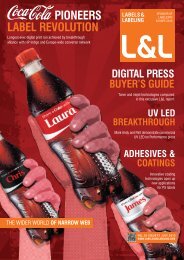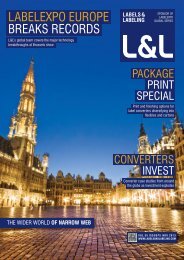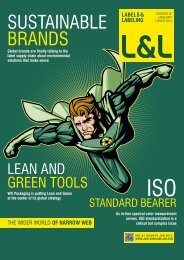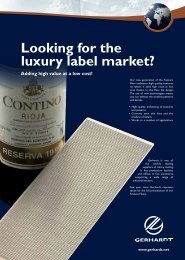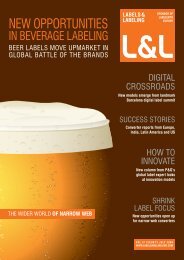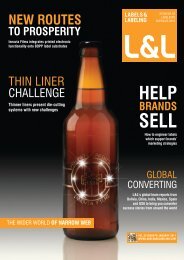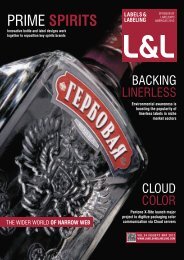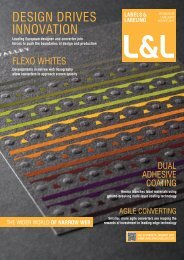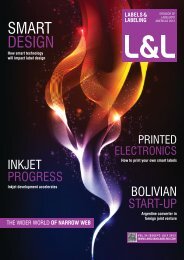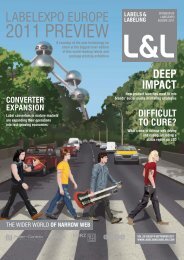THE DATA FRONT
Download as PDF - Labels & Labeling
Download as PDF - Labels & Labeling
- No tags were found...
You also want an ePaper? Increase the reach of your titles
YUMPU automatically turns print PDFs into web optimized ePapers that Google loves.
86<br />
remember having burnt their fingers by<br />
committing themselves to Gen 1-based systems<br />
for too long. RFID is essentially a highly competitive and<br />
complex world. Traditionally, converters and suppliers have<br />
struggled to become established and must therefore continue<br />
to rely on access to reliable resources. It's like a hand holding<br />
exercise where access to sound expertise is essential.'<br />
Not everybody is pro-RFID. In fact, various campaigning<br />
groups argue that if you can track and trace a pallet, you can<br />
apply this to people. That is, surreptitiously read a secreted tag<br />
at a distance with the intent of gathering sensitive data without<br />
an individual's consent. They also say that fraudsters can read<br />
the globally unique ID of a purchased item from a RFID tag<br />
and indirectly identify a purchaser's credit, debit or loyalty card<br />
details. The debate was controversially joined by a self-styled<br />
'ethical hacker' from California. On a YouTube clip he showed<br />
how easy it was to skim RFID tags embedded in the new<br />
electronic US passports at long-range using a portable reader.<br />
Industry experts are highly skeptical. They point to the high<br />
level of secure encryption offered by today's UHF Gen 2 tags<br />
and inlays, including optional 32-bit password to access or lock<br />
tag data, or permanently disable it. This compares with the 8-bit<br />
password used in Gen 1.<br />
Alternative technologies<br />
As far as label converters are concerned, the various on-line<br />
and<br />
off-line variable<br />
information printing methods<br />
will see further progress with linear and<br />
two-dimensional barcoding symbologies. The RFID<br />
situation is harder to predict. It would seem chip makers,<br />
software developers and printer/encoder manufacturers have<br />
hitched their fortunes to UHF Gen 2 technology. They are sure<br />
it provides a practical platform for future growth in more areas.<br />
Nevertheless, older protocols will continue in use, subject to<br />
revisions or replacement by newer versions. Each requires<br />
separate reading and encoding equipment, supported by<br />
dedicated management infrastructures. This explains why<br />
several manufacturers have developed printer-encoders with a<br />
multi-protocol capability. In a white paper, Zebra Technologies<br />
says they are the answer to a diverse RFID environment,<br />
pointing out that even Gen 2 supports a large number of<br />
chip-compliant variables in terms of memory size, re-writeability<br />
and data security. A multi-protocol approach accommodates<br />
these options and perhaps future upgrades too.<br />
The unknown issue is whether the latest techniques for<br />
printed electronics pose a challenge to conventional inlay<br />
manufacturing methods. In pursuit of producing inexpensive<br />
antennas, several converters have applied rotary screen,<br />
gravure, inkjet and even flexo with varying results. In a<br />
fast-changing scenario, some companies have begun to<br />
exploit the technology. Significantly, in March last year Stork<br />
Prints announced the installation of a customized rotary screen<br />
A 'Squiggle' antenna for a UHF tag from Alien Technology<br />
Labels&Labeling<br />
A 'wet' inlay in the DogBone series from UPM Raflatac



